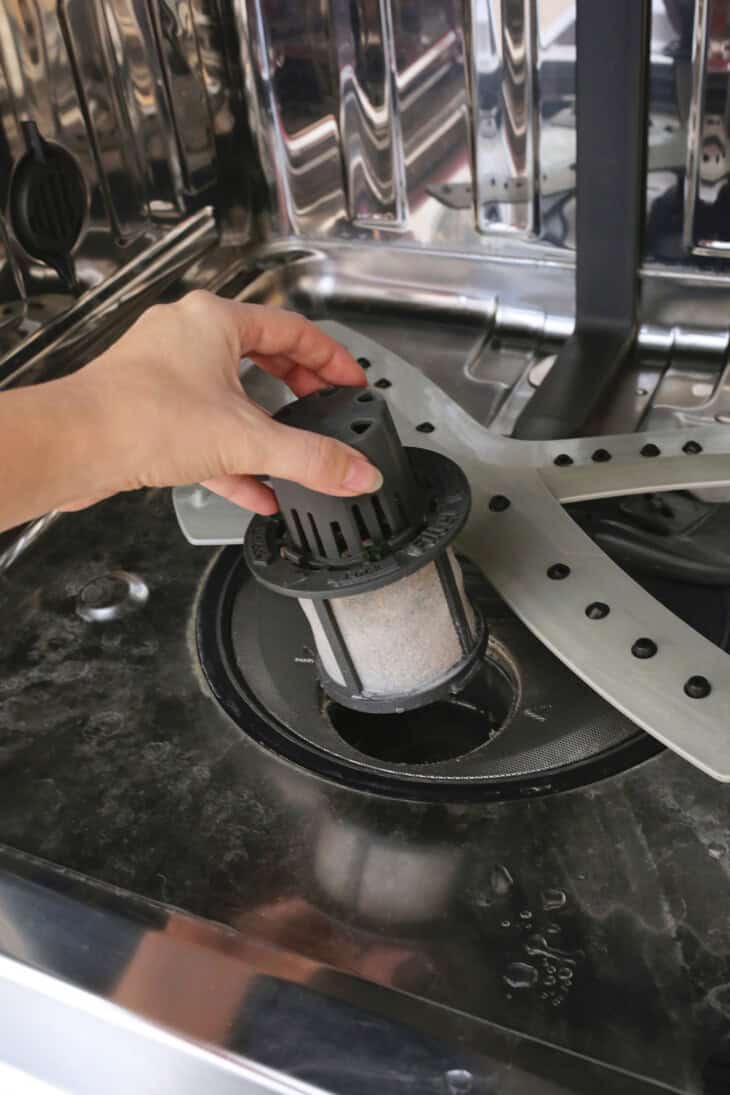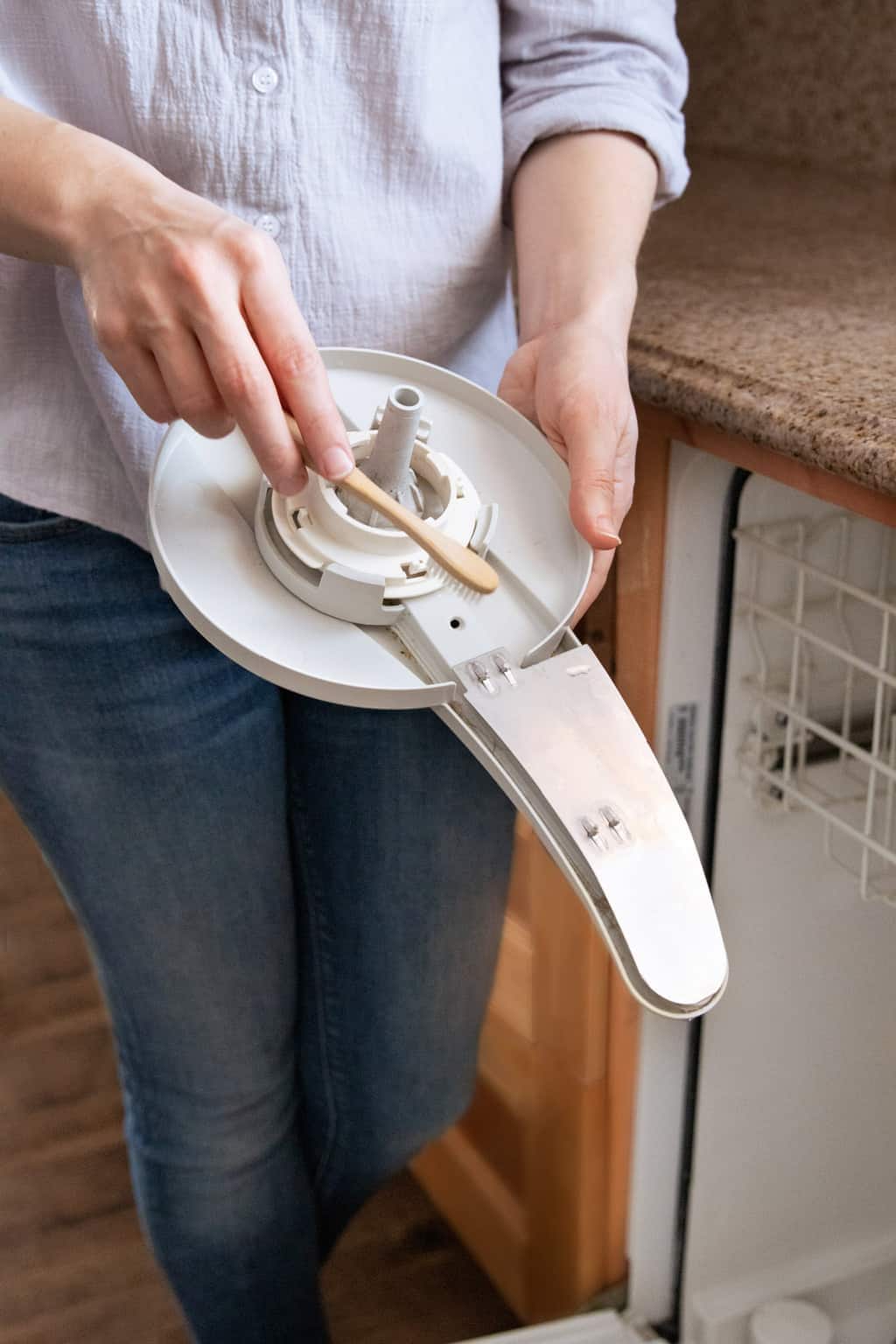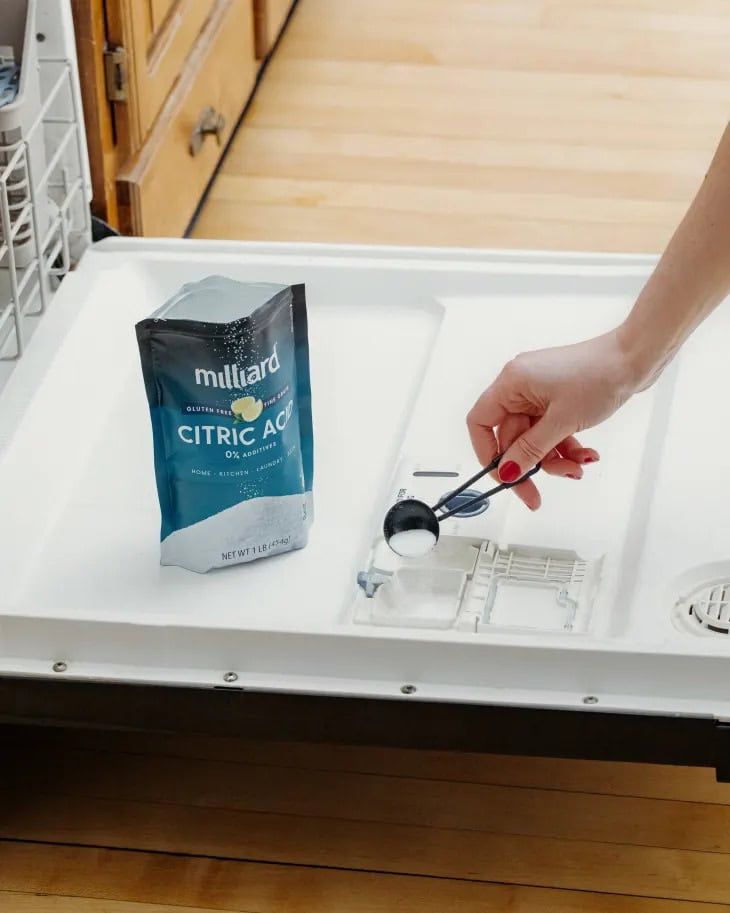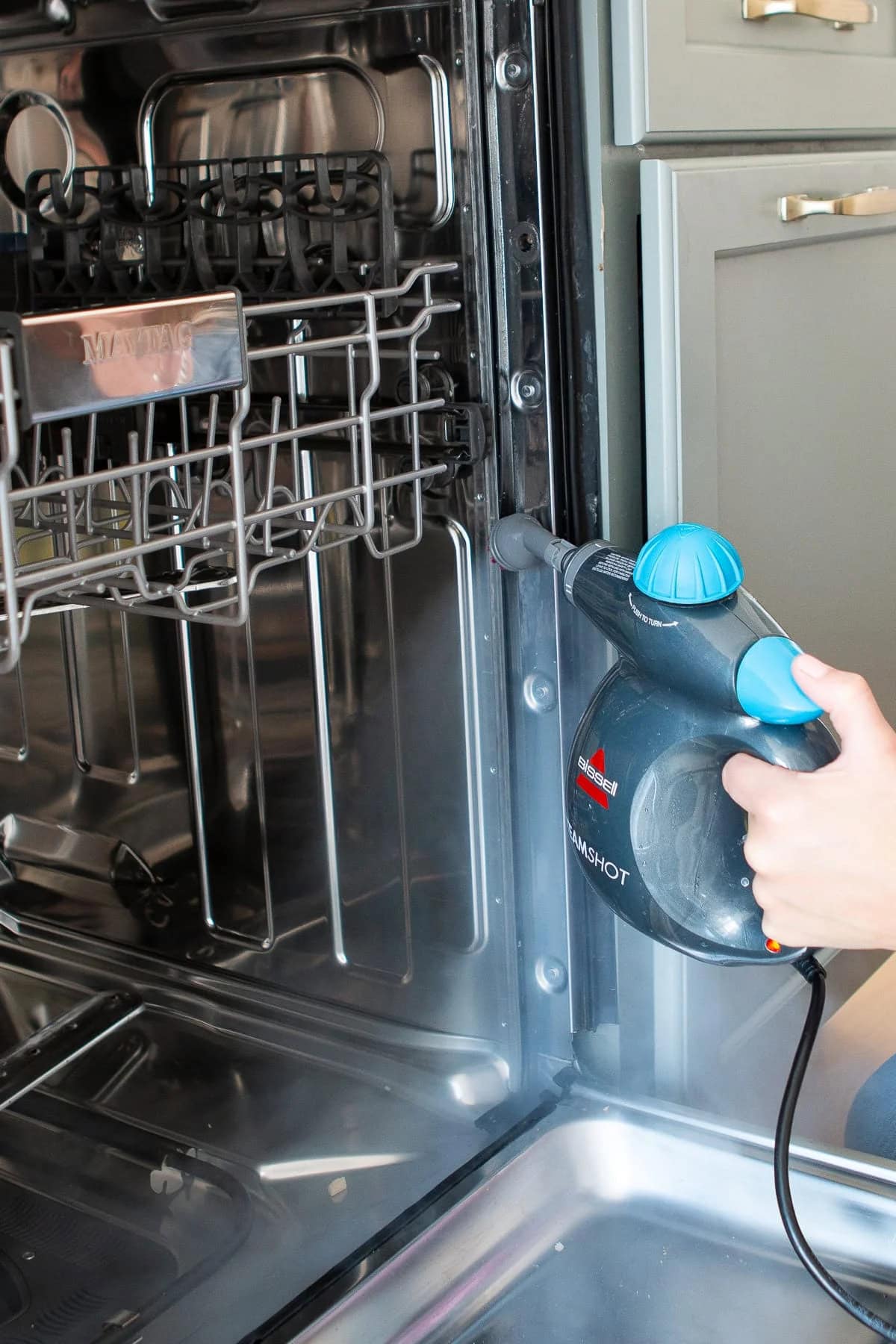Learning how to deep clean your dishwasher might seem unnecessary until your dishes come out cloudy, smelly, or still covered in food particles.
You expect your dishwasher to leave things spotless, not add strange odors or white residue that make you question its performance.
Many people assume running hot water and detergent is enough, but grime builds up in places you don’t see, like spray arms and filters.
It’s frustrating to open your machine expecting clean dishes, only to find streaks, spots, or weird smells that ruin the results.
Food scraps, grease, and soap scum gather over time and create buildup that clogs spray holes and lowers cleaning power.
Some people try switching detergents or rinse aids, but the issue often comes from a dirty machine, not the products you’re using.
Ignoring the problem can lead to mold, bacteria, and limescale inside the washer, which can even affect your family’s health.
This post may contain affiliate links. As an Amazon Associate and a participant in other affiliate programs, I earn a commission on qualifying purchases at no additional cost to you.

You may feel stuck washing things twice or scrubbing dishes by hand before loading, which defeats the purpose of having a dishwasher.
But once you learn how to deep clean your dishwasher the right way, it starts running better and makes dish duty a whole lot easier.
A clean dishwasher works better and gives you a chance to tidy up the kitchen and refresh your space inside and out.
Why You Should Deep Clean Your Dishwasher Regularly
Even though your dishwasher runs hot water and soap, it still collects grime, food bits, and grease in all the hidden corners and parts.
Over time, this buildup clogs spray arms, blocks filters, and lowers water pressure, so your dishes don’t come out fully clean anymore.
You might notice a sour or musty smell when opening the door, which means bacteria and mold have started growing inside the machine.
Streaks on glassware or a white film on your plates are signs that your dishwasher isn’t rinsing properly due to trapped buildup.
If you let it go too long, the machine can grow mold, attract pests, or even start leaking from clogged drains or hoses.
It’s frustrating to trust your machine, then see dried food or stuck-on gunk after a full cycle you paid water and power for.
Deep cleaning helps the dishwasher run more efficiently, saving you from high energy bills and water waste caused by repeat loads.
It also keeps the interior parts in better shape, helping your appliance last longer without needing expensive repairs or full replacement.
You’ll get cleaner dishes, fewer smells, and better performance, all from a simple task that only takes a little time and effort.
Once you get in the habit, you’ll wonder how you ever lived with a dishwasher that wasn’t regularly cleaned and cared for.

How Often Should You Deep Clean Your Dishwasher?
You don’t need to deep clean your dishwasher every week, but you do need to stay on a regular schedule to keep it working properly.
Most people can get by with a deep clean once a month, especially if they rinse dishes lightly before loading the machine.
If your dishwasher starts to smell bad or dishes aren’t coming out clean, it’s time for a deep cleaning, even if it’s ahead of schedule.
Homes with hard water, heavy use, or larger families might need to be cleaned every two weeks to avoid mineral buildup and stuck-on grease.
Check your manual for specific care instructions, since some machines have self-cleaning filters or extra parts that require different cleaning routines.
Even if your dishwasher looks clean on the outside, the inside can still hide gunk in the filter, drain, and detergent dispenser area.
A regular wipe-down helps, but a full deep clean clears out the buildup you can’t reach during daily or weekly maintenance.
Waiting too long makes the job harder, since buildup hardens and takes more scrubbing to remove completely from interior surfaces.
Add a reminder to your calendar or pair the task with another monthly chore like changing air filters or wiping down the fridge.
Once it becomes routine, you’ll enjoy a dishwasher that smells fresh, runs strong, and gives spotless dishes every time.

What You’ll Need To Clean Your Dishwasher
You don’t need fancy supplies to deep clean your dishwasher, just a few common household items that break down buildup and kill bacteria.
Would you like to save this post?
These items are safe, effective, and affordable ways to freshen the inside of your machine without damaging the parts or surfaces.
- White vinegar
- Baking soda
- Old toothbrush
- Toothpick or paperclip
- Dish soap
- Microfiber cloth
- Sponge or scrub pad
- Warm water
Tap Photos To Shop
Step-By-Step: How To Deep Clean Your Dishwasher
Deep cleaning your dishwasher doesn’t take long, but it does make a huge difference in how well it works and smells.
Follow these simple steps to remove hidden grime, boost performance, and get your machine back to doing its job properly every single time.
1. Empty the dishwasher
Remove all plates, glasses, and utensils so you can reach every surface without anything blocking your path or covering the spray arms. It’s important to start with a clean machine so no food bits or detergent from dishes interfere with your cleaning efforts. Wipe off any crumbs or visible debris sitting at the bottom before starting the deeper steps in the process.
2. Remove and rinse the filter
The filter usually sits at the base and pops out easily, but check your manual if you’re unsure how to remove it safely. Soak it in warm, soapy water and use a toothbrush to scrub away anything stuck in the mesh or plastic frame. Rinse thoroughly under running water to remove all soap, then set it aside to dry while you clean other parts of the machine.
3. Inspect the spray arms
If your model allows, remove the spray arms, then hold them under a light to find clogged holes or trapped debris inside. Use a toothpick, paperclip, or soft wire to carefully poke through each hole and clear out anything that’s blocking water flow. This step improves how well the water reaches your dishes and helps restore the pressure your dishwasher needs to clean properly.
4. Wipe down the door edges, seal, and detergent tray
Use a damp cloth to scrub the rubber seal, which often traps old detergent, food grease, and mildew along its folds. Pay special attention to the corners and hinges where buildup loves to hide but rarely gets wiped during normal use. Clean the detergent and rinse aid trays thoroughly so your cleaning products can do their job without being blocked or diluted.
5. Place a cup of white vinegar
Vinegar breaks down grease, softens mineral deposits, and kills bacteria that cause your dishwasher to smell musty or sour. Keep the bowl upright in the center of the top rack so the vinegar spreads evenly during the wash cycle. This step helps flush out buildup from the inside walls, spray arms, and hard-to-reach areas like the drain and corners.
6. Sprinkle one cup of baking soda
Baking soda absorbs odors and scrubs away any leftover stains or stuck-on grime left behind from the first cycle. Spread it evenly across the bottom of the tub so it dissolves fully and can reach every surface while the water runs. This step leaves your dishwasher smelling fresh and looking cleaner without harsh chemicals or bleach-based products.

7. Scrub the inside walls and racks
Use a non-abrasive sponge or dishcloth and gently scrub any areas with visible buildup that didn’t come off during the cleaning cycles. Look closely at the corners, rack tines, and side walls where soap scum and grime tend to cling over time. Rinse the sponge often to avoid spreading gunk around and keep scrubbing until everything looks clean and fresh.
8. Wipe down the control panel and exterior
Spray a cloth lightly with soapy water and gently wipe the handle, buttons, and front panel of your dishwasher. Make sure not to let water drip into the buttons or controls, since that can damage electronics or affect how they work. A clean exterior makes the whole kitchen feel neater and helps your appliance look just as good as it runs.
9. Check the drain at the bottom
Look around the base of the tub near the filter for anything that might be stuck, like broken glass, bones, or food particles. Use a paper towel or a gloved hand to remove any visible mess so water can drain smoothly after every cycle. A clean drain prevents odors, clogs, and standing water that can lead to mold or bad smells inside the machine.
10. Leave the door open to air
Prop the door open a few inches so leftover moisture can escape and the inside has time to dry completely. This step stops musty smells and keeps the rubber seals from staying damp, which is a common cause of mold growth. Do this after every wash if possible, not just after deep cleaning, to help keep your dishwasher dry and smelling fresh.

Frequently Asked Questions
Food scraps, grease, and trapped moisture collect in hidden parts of the dishwasher, causing sour or musty smells that only deep cleaning can remove completely. Without regular cleaning, bacteria and mold grow in the filter, seals, and drain, making your dishwasher smell worse with every load you run.
Yes, your dishwasher still needs deep cleaning because grease, soap scum, and food debris build up even when it’s running regular wash cycles daily. Without routine cleaning, these layers reduce performance, increase odors, and leave dishes less clean, no matter how powerful the dishwasher setting is.
You can use both, but for better results, run vinegar during one hot cycle, then baking soda in a second short cycle. Using them separately avoids foam overflow and lets each cleaner work at full strength to remove smells, grease, and mineral deposits more effectively.
White vinegar breaks down grease, soap film, and odors, while baking soda scrubs surfaces and neutralizes smells without damaging dishwasher parts. Both are safe, affordable, and effective options that clean deep without relying on harsh chemicals or expensive specialty products.
Yes, the filter collects grease, bits of food, and debris that can clog drainage, reduce cleaning performance, and lead to nasty smells if ignored. Cleaning the filter regularly helps water flow properly, keeps dishes cleaner, and prevents gunk from spreading throughout your dishwasher during each cycle.

Many people don’t realize how to deep clean their dishwasher until it stops working well or starts to smell every time they open the door.
Knowing how to deep clean your dishwasher the right way saves time, improves performance, and keeps your kitchen feeling cleaner overall.
Once your machine is fresh again, you’ll notice a big difference in how your dishes look, feel, and even smell after each cycle.
It also gives you a chance to organize the kitchen by wiping nearby cabinets, adding under-sink storage, or refreshing decor with small touches.
Clean appliances make every chore feel lighter and help your home feel more put together without investing time or money.












